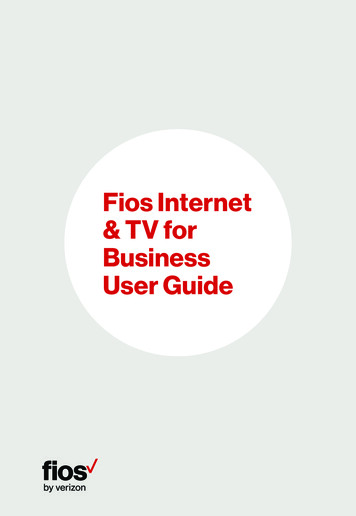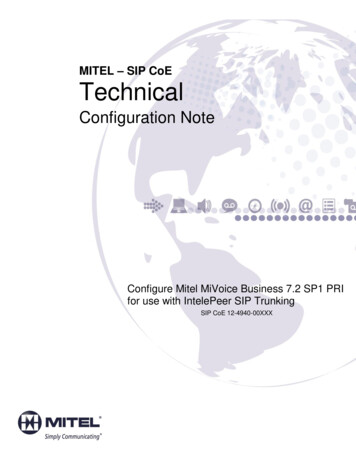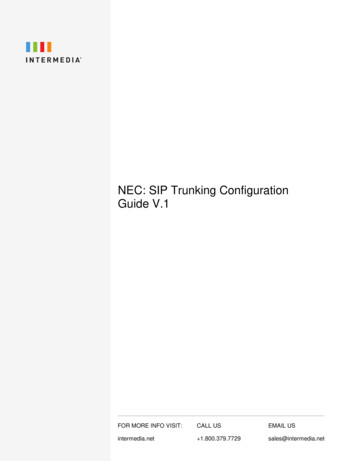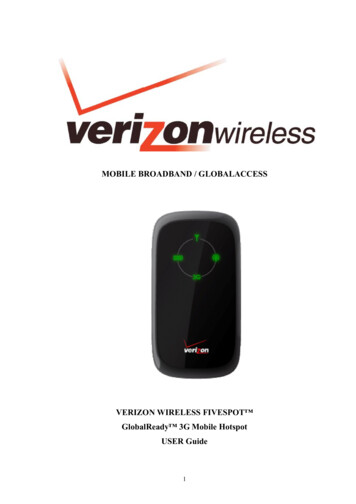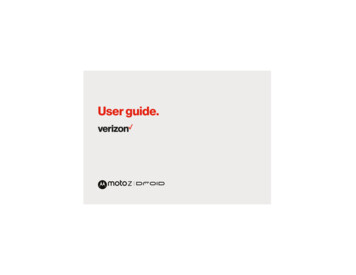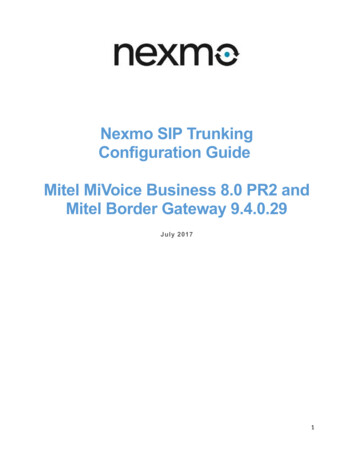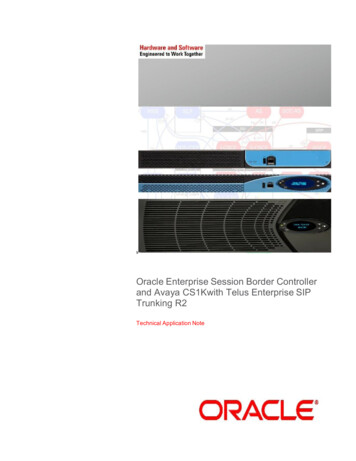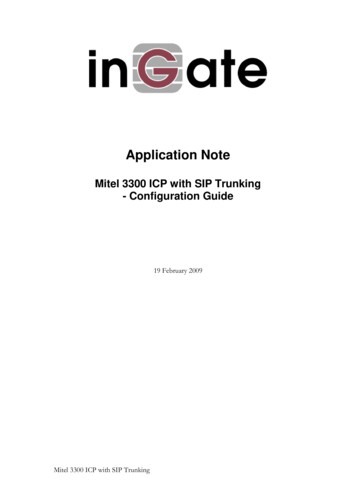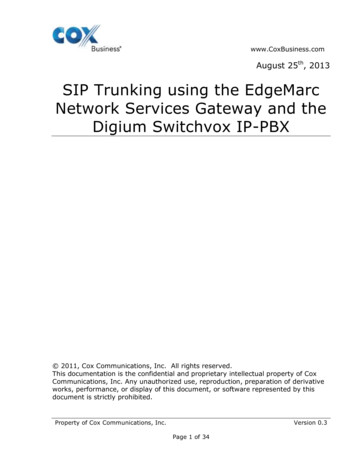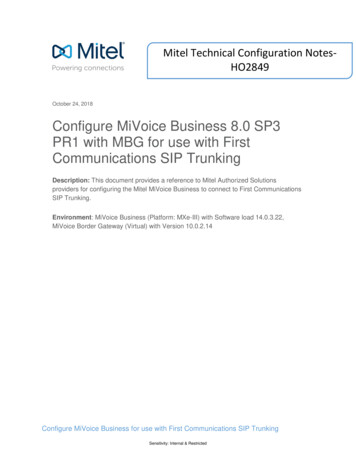
Transcription
Application NoteVerizon IP Trunking and IP Contact Center Services: ConnectingCisco Unified Communications Manager 8.0.3 with Cisco UnifiedBorder Element 8.5 (Enterprise Edition)May 10, 2011 - Initial VersionTable of ContentsIntroduction . 2Verizon IP Trunking Overview . 2Verizon IPCC Overview. 2Network Topology . 3System Components . 3Hardware Components . 3Software Requirements . 3Sample Bill of Materials . 4Features and Known Limitations . 4Features Supported (IP Trunking) . 4Known Limitations (IP Trunking) . 4Features Supported (IPCC). 5Known Limitations (IPCC) . 5Cisco UBE Features Roadmap . 5CISCO UCM 8.X SIP Trunk Deployment Considerations . 6Call Flow Overview. 6Outbound Call Flows. 6Inbound Call Flows . 7Failover . 7Known Issues. 7Inbound Call Issues . 7New Security Operation in Cisco IOS 15.1.2T. 9Redirected Dialed Number Identification Service and Diversion Header . 9RDNIS Configuration in Cisco Unified Communications Manager Administration . 10CISCO UCM Administrator Device Device Settings SIP Profile . 12CISCO UCM Administrator Device Device Settings SIP Profile . 14Communications Manager Configuration . 15Media Resource Group List. 15Media Resource Group . 15CODEC Selection using Device Pools and Regions . 17Clusterwide Parameters (System- Location and Region) . 19List of Device Pools and the associated Regions. 20List of Phones and ATA Devices . 20SIP Trunk Configuration . 21Route Group Configuration . 22Route List for Voice . 24Route List Details for Voice . 24Route List for FAX. 25Route List Details for FAX . 26Route Plan report for Voice and FAX Offnet calls . 27CISCO UBE Example Configuration (North America). 29 2010 Cisco Systems, Inc. All rights reserved.Important notices, privacy statements, and trademarks of Cisco Systems, Inc. can be found on cisco.comPage 1 of 52EDCS# 994149 Rev # Initial VersionNote:Testing was conducted in Verizon lab.
EMEA Configuration. 38EMEA CISCO UCM Configuration . 38EMEA CISCO UBE dial-peer Configuration . 43IPCC Configuration . 44IPCC CISCO UCM Configuration . 44IPCC CISCO UBE dial-peer Configuration . 46Troubleshooting . 47References . 50Acronyms . 50Important Information . 51IntroductionThis application note describes how to configure a Cisco Unified Communications Manager (Cisco UCM) 8.0 and Cisco Unified BorderElement (Cisco UBE) Enterprise Edition 8.5 for connectivity to Verizon’s IP trunking service. The deployment model covered in thisapplication note utilizes Verizon’s Private IP (commercial MPLS network) to access Verizon IP Trunking. Supplemental guidelines are alsoincluded for using Verizon IP trunking to interface to their IP-based Contact Center Service or IPCC. Please note that in the context of thisdocument, “IPCC” refers to a cloud-based Contact Center product from Verizon, and should not be confused with a Cisco product. Additionalsupplemental guidelines are provided for an EMEA configuration.Testing was performed in accordance with the test plans for the Verizon IP trunking (US and EMEA), and IP Contact Center services. Allfeatures were verified.Although this document does not detail the results of the testing performed it provides the essential configurationsrequired for SIP interoperability with Cisco UCM/Cisco UBE and the Verizon IP Trunking and IPCC services.Verizon IP Trunking OverviewVerizon IP trunking services simplify management of your network and can help drive operational efficiencies. They do this by consolidatingyour voice services onto a SIP-based VoIP network, thereby optimizing your data IP network, and controlling costs associated with maintainingtraditional TDM local lines, trunks, and dedicated PRI circuits. Verizon also offer a native IP Trunking option that provides a SIP trunk directlyto your IPPBX, and an IP Integrated Access option that leverages a gateway device so you can interface with legacy Key or PBX systems.And, Verizon’s latest Burstable Enterprise Shared Trunking (BEST) feature enhancement allows you to share all your voice trunking resourcesacross your enterprise and lets you use idle trunk capacity in one location to accommodate a traffic increase in another location. BEST helpscontrol costs, as fewer concurrent calls need to be purchased at each location and resources can be shared to provide time of day benefits andpeak usage management.Verizon IPCC OverviewVerizon VoIP Inbound is a component of the IP Contact Center (IPCC) portfolio of internetworking services, which tightly couples signalingand functionality from the Advanced Toll Free and IP networks to deliver the intelligent routing and call treatment required by contact centers.The IPCC services are network-based and include IP Interactive Voice Response (IVR) in addition to VoIP Inbound.VoIP Inbound is standards-compliant and provides single-call service that allows PSTN-originated Toll Free calls to seamlessly terminate andtransfer to a SIP or TDM endpoints, without call re-originations that tie up CPE port capacity. VoIP Inbound includes advanced toll free features 2010 Cisco Systems, Inc. All rights reserved.Important notices, privacy statements, and trademarks of Cisco Systems, Inc. can be found on cisco.comPage 2 of 52EDCS# 994149 Rev # Initial VersionNote:Testing was conducted in Verizon lab.
including automatic ISDN User Part and SIP Error overflow for reliable termination to SIP or TDM devices anywhere; and, when combinedwith IP IVR, supports customer-driven pre/post call routing and/or call treatment and queuing for customers using Cisco ICMNetwork TopologyFigure 1. Typical Reference NetworkSystem ComponentsHardware Components CISCO UBE IOS version 15.1.2T2. Primary and Secondary CISCO UBE routers are used for high availability. Cisco Unified Border Element is an integrated Cisco IOS Software application that runs on various hardware platforms, for more details:http://www.cisco.com/go/cube Packet Voice Data Module (PVDM). You will need to install DSP modules on a supported ISR platform if you require MTP,Transcoding or Conference Bridge resources. These DSP resources are co-resident on the CISCO UBE routers in our lab configuration. CISCO UCM cluster with (2) Cisco MCS 7800 Series servers (Cisco Unified Communications Manager) Cisco Unified IP Phones Analog Telephony Adapter for FAX, modem, or analog phones Ethernet Switch WAN router used to terminate the Verizon MPLS networkSoftware Requirements Cisco Unified Call Manager 8.0.3 Cisco Unified Border Element CISCO UBE running IOS version 15.1.2T2 2010 Cisco Systems, Inc. All rights reserved.Important notices, privacy statements, and trademarks of Cisco Systems, Inc. can be found on cisco.comPage 3 of 52EDCS# 994149 Rev # Initial VersionNote:Testing was conducted in Verizon lab.
Sample Bill of -7965DescriptionUnified CM 8.0 7835-I3 ApplianceAC Power Cord (North America), C13, NEMA 5-15P, 2.1mC2921 VSEC CUBE Bundle, PVDM3-32, UC SEC Lic, FL-CUBEE-25Cisco 2901-2921 IOS UNIVERSALAC Power Cord (North America), C13, NEMA 5-15P, 2.1mCatalyst 2960 24 10/100/1000, 4 T/SFP LAN Base ImageAC Power Cord (North America), C13, NEMA 5-15P, 2.1mTop Level Sku For User LicenseLicense - 1 Basic UserCUCM 8.0 7835Cisco VG202 Analog Voice GatewayAC Power Cord (North America), C13, NEMA 5-15P, 2.1mCisco Voice Gateway 20x Series ADVANCED IP SERVICESCisco Unified IP Phone 7962CUCM 3.x or 4.x RTU lic. for single IP Phone 7962Cisco Unified IP Phone 7965, Gig Ethernet, ColorCUCM 3.x or 4.x RTU lic. for single IP Phone 7965QuantityFeatures and Known LimitationsFeatures Supported (IP Trunking)For a full list of supported SIP features please refer to the “Verizon Business Retail VoIP Network InterfaceSpecification (for non-registering devices)” document.All Tests were performed according to the” Verizon Business Retail VoIP Interoperability Test Plan” and the “EMEARetail - Test Plan” documents.These documents may be obtained by contacting your Verizon Business Account Representative.Known Limitations (IP Trunking) DTMF as RFC2833 NTE (named telephone events) when a compressed audio codec is used. Note: RFC2833 is not currently supportedwhen using CTI Route-Points on CISCO UCM 8.0. An MTP resource is required to enable DTMF relay for any calls that utilize a CTIRoute-point. CISCO UBE performs Delayed-Offer to Early-Offer interworking of the initial SIP INIVTE from CISCO UCM. The Cisco UBE devicereceives the invite with no SDP then forwards the invite to the SIP network with SDP included. T.38 Fax relay is not supported by Verizon IP Trunking Service at this time Note: If you have a Cisco Fax Server or other T.38 Faxdevice, you will need to ensure that design considerations have been made to support this outside of the Verizon IP Trunking service.(i.e. T1 PRI) 2010 Cisco Systems, Inc. All rights reserved.Important notices, privacy statements, and trademarks of Cisco Systems, Inc. can be found on cisco.comPage 4 of 52EDCS# 994149 Rev # Initial VersionNote:Testing was conducted in Verizon lab.242222215021112233
Outbound SIP REFER with Replaces. CISCO UCM does not currently support generation of an outbound SIP Refer with replacesmessaging. CISCO UCM 8.0 can only support a single codec between the end device (i.e. IP Phone, ATA) and the SIP Trunk. A workaround forthis used during testing was to create multiple Regions and Device pools in order to control the codec selection prior to being presentedto the SIP Trunk. The end devices were configured with a specific Device Pool based on the codec used for off-net calls. This isespecially true for mid-call codec negotiation, for any calls that require changing of the initial negotiated codec the CISCO UBE devicewill insert a transcoder resource in order to avoid a codec mis-match between the SIP provider and the CUCM end-points. The CISCO UBE device must have transcoder resources configured on the Cisco UBE device and registered with CUCM to support themid-call codec change features on Cisco UBE. This feature allows for dissimilar Voice Class Codec configurations on the incoming andoutgoing dial peers. In order to comply with Verizon’s requirement of supporting g711u as a secondary codec for all calls and for performing Mid-CallCodec Negotiation, Cisco has provided an acceptable solution of providing this feature via the Cisco UBE by performing transcodingfrom Call Manager to SIP Trunk out to the networkFeatures Supported (IPCC)For a full list of supported SIP features please refer to the “Verizon Business IP Contact Center (IPCC) TrunkInterface Network Interface Specification” document.All Tests were performed according to the” Verizon Business IPCC Interoperability Lab Test Plan”These documents may be obtained by contacting your Verizon Business Account Representative.Known Limitations (IPCC) The IPCC service does not currently support SIP Diversion Headers The IPCC service does not support FAX Outbound SIP REFER with Replaces. CISCO UCM does not currently support generation of an outbound SIP Refer with replacesmessaging. CISCO UCM 8.0 can only support a single codec between the end device (i.e. IP Phone, ATA) and the SIP Trunk. A workaround forthis used during testing was to create multiple Regions and Device pools i
May 10, 2011 · included for using Verizon IP trunking to interface to their IP-based Contact Center Service or IPCC. Please note that in the context of this document, “IPCC” refers to a cloud-based Contact Center product from Verizon, and should not be confused with a Cisco product. Additional supple
